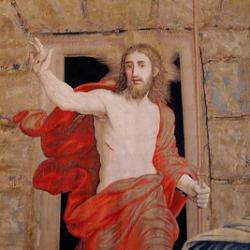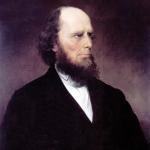The Bible
There is a new addition to my office, a brown leather copy of Holy Scripture. I ordered it when I was at a denominational meeting this summer. Not often do I find my favorite translation in a comfortable size, so when I found this one I was excited. The two gold ribbons for page markers are tucked in Genesis and Isaiah, where my reading is right now. I do not need a ribbon for the Psalms, as I follow the date as I read the Psalter. No, I suppose I did not need a new Bible, but there is a little bit of joy one gets reading the Gospel in a new Bible that is difficult to enunciate.
I spend most of my professional life considering the Scriptures and proclaiming their meaning. If you were to come to my office you would probably find me reading theologians who reflect on the meaning of the Gospel, reading commentaries about the Scripture for Sunday, or thinking through what the Scriptures mean for today. My life centers on this sacred text.
The Bible is an amazing book. Composed of two Testaments, it was written by 35 authors over a period of about 1500 years. It presents a unified message about our need for salvation and our hope for the future.
The Scriptures have not only shaped my life; they have shaped Western Civilization. It is difficult to understand our culture without reference to the Bible.
The Gospels
A unique feature of the New Testament is that there are four accounts of the life of Jesus, not just one. The 4 Gospels, Matthew, Mark, Luke, and John, serve as the Church’s witness to the life of Jesus.
The first three Gospels are the “Synoptics,” a Greek term meaning “see together.” Some even call them “look-alike” Gospels. If you could take Synoptics and place them side by side in columns, just how similar they are might surprise you. It is not just that they tell the same stories of Jesus, it is that they tell them with similar wording. Sometimes, the wording is verbatim.
Who Wrote The Gospels: New Testament Scholar Ben Witherington
The Synoptic Problem
This similarity is what scholars will call the “Synoptic Problem.” The most common solution to the Synoptic Problem is called the 4 Source theory. This theory is that there is a long-lost document previous to the Gospels called Q or Quelle meaning “source.” This hypothetical document contains a list of the sayings of Jesus and other material. The theory suggests that Mark was the first to write his Gospel, and he did not have access to Q. Matthew and Luke wrote next. Both of them had access to Mark and Q, but not to each other. Luke and Matthew both had independent sources that the other did not have. The name of these proposed sources is L and M. While the theory is imperfect, it is common among commentators of the New Testament.
John
Lastly, there is John, and John is different. He does not follow the chronology of Mark as Matthew and Luke do, nor does he give a birth narrative. He begins not with the beginning of Jesus’ ministry, but with Jesus in eternity. Although I like to read John immensely, I find it hardest to preach from because John focuses on long dialogues not short scenes like in the other Gospels.
Why Not Compile The Gospels?
An early Christian thinker named Tatian tried to reduce the 4 Gospels to one, but the wisdom of the Church was to keep the 4 as they were. While it is tempting to reduce the Gospels to one voice, each of them has a different emphasis, and listening to each Gospel by itself helps discern its authentic voice.
Gospel Distinctives
If tradition is true, Mark was writing in Rome near the time Peter’s death. Mark is the Gospel told through the lens of Peter’s experience. While it is not certain that Mark was first, the earliest Christian thinkers are clear on the connection to Peter. The tradition that Mark was a disciple of Peter is ancient, and there is little reason to doubt it.
I find few people who would say that Mark is their favorite Gospel. It lacks Luke’s vivid language, the teaching sessions of Jesus are more abbreviated than in Matthew, and John’s poetic mastery is missing. What Mark misses in language, extended teaching sessions, and elegant prose, it makes up for with passion.
How to Read Mark
Imagine a 4-year-old girl running to her grandfather after a trip to Disney World. As you read this next paragraph, take on the voice of an excited little girl. If you can “hear” it in your head, all the better. She probably sounds like:
I saw Elsa, and Anna, and Belle, and rode the teacups, there was a carousel, and I got to see the Castle, and Tinkerbell flew down from the castle during the fireworks, and Minnie and Mickey were there, and I got an autograph from Pooh Bear, and Piglet gave me a hug. There were rides, and I got to go on Space Mountain. I was just barely tall enough, and there was a snack after the ride. At breakfast, I saw Cinderella, and Snow White, and PJ Masks, and Woody, and Jesse, and Tiana. I rode Pirates of the Caribbean, and saw the parade, and rode the train, and Big Thunder Mountain Railroad, and then we went to Animal Kingdom, and I saw Timone and Pumbaa, and then we went to Epcot and I went to Mexico, and England, and then we ate in France. And after that, we saw the laser light show and rode the giant ball…
That is how Mark’s Gospel sounds. He hardly stops to breathe. In the NASB translation of Mark the word “and” appears 744 times in 443 verses. A modern English teacher would get nauseous at Mark’s run-on sentences. Mark, however, has a point with all of his hurry. He is hurriedly telling you about Jesus.
Mark’s Jesus
Mark presents Jesus as the victor over the evil powers. In the first chapter, before we have even gotten to know Jesus, He is bossing demons around. “Be quiet,” He shouts. Of course, this is a polite version of what Jesus said. The Greek word means “be muzzled.” The only modern English that gets close to His meaning is “Shut up!” He uses the same word in 4:39 when He rebukes the sea and wind. Mark pictures the storm that incites Jesus’ ire as not so much a normal weather event but a demonic assault. When the storm arises, the Disciples are terrified of the storm. After Jesus rebukes the wind and waves, they are terrified of Jesus. Why fear? Because they know only God can rebuke nature and evil.
How to Read Matthew
The Gospel of Matthew is anonymous, nowhere in the text is the author’s name. The early Christian leader Papias connects Matthew’s name to the Gospel in 130, and there is no reason to dispute him. Important to note, Matthew and John are the only Gospels written by eyewitnesses.
In presenting Jesus as Israel’s Messiah, Matthew carefully puts Jesus’ genealogy first. For modern readers, this is unpleasant. After all, who cares who begat whom and when? Now paying careful attention will yield important lessons in the genealogy, but moderns have to be forced to pay attention. All of these “begets”despite are as interesting as watching slugs race through syrup or a bowling tournament on ESPN when football is on hiatus. “Get to the good stuff!” For the ancient Jew, Matthew’s audience, however, that genealogy is very impressive. Jesus can not only go back to Abraham but Adam!
Preaching from Matthew’s Gospel: Major Themes and Forms of Teaching
In Matthew, you will find Jesus sitting down to give people instructions on how to live. He is the prophet like Moses, the One Moses foretells. Matthew also gives extended time to the teaching of Jesus. In the Gospels, Jesus gives about 36 parables. 20 of them are in Matthew.[1]
Matthew’s Jesus
One clear emphasis in Matthew is Jesus as the Davidic Messiah. Matthew narrates the birth of Jesus through Joseph’s lens as one would expect from a writer communicating with a Jewish heritage. The story of the Wise Men functions as a declaration of the royalty of Jesus. “Where is He that is born King of the Jews?” This question makes Herod with his tenuous claim for that title quiver with fear and fly into a murderous rage.
When reading Matthew, look for royal images, allusions to Moses, long teaching sections, and descriptions of the Kingdom of Heaven.
How to Read Luke
Luke’s Gospel uses the most advanced Greek grammar and the largest Greek vocabulary of the Gospels. As one would expect from a medical doctor, Luke can give details about bodies and medical conditions. Luke was also a companion of Paul during Paul’s missionary journeys. Many modern interpreters like to put Paul and Jesus in tension. If that tension were real, Luke would have picked it up. Luke’s connection to Paul shows Paul is in continuation of the ministry of Jesus.
Luke tells the reader in Chapter 1 that he wanted to create an orderly account of the life of Jesus. In doing this task, he interviewed eyewitnesses to Jesus’ ministry, Luke states. I maintain that one of those witnesses was Mary, the mother of Jesus.
Luke writes, “… but Mary kept all of these things and pondered them in her heart.” He recounts her visit with Gabriel, announcing the conception of Jesus, the story of Mary and Elizabeth. He also records Mary’s remarkable song at Elizabeth’s house, the Magnificat. Luke also tells us of Jesus’ infancy visit to the temple where Simeon and Anna recognize the infant as Lord. Much to Mary’s chagrin, I imagine, Luke recounts the story where Joseph and Mary lose Jesus for a few days.
Luke’s Jesus
Luke presents Jesus as the Lord. Jesus is the Lord of the Kingdom of God, the rightful ruler. All others are pretenders and usurpers to the throne. At the outset of the story of Jesus, angels visit shepherds with the announcement, “Unto you is born this day in the City of David, a Savior which is Christ the Lord.”
In Luke’s mind, the Kingdom of God is steadily reorienting the world with a process that cannot be denied or delayed. The world is the focus for Luke as he tells the reader of the Gentiles (when reading the Gospels, it would be good to think of Gentiles not just in racial terms but in religious terms. Gentiles were pagans.) who come to know the Lord.
How to Read John
John is different. Despite his limited use of Greek vocabulary, his writing is the most poetic of the Gospels. In John 1, John communicates the pre-incarnate nature of Jesus, describe Jesus in divine terms, and discuss the incarnation. More than that, John does that poetically. This combination is extremely tricky. Most texts in the history of Christianity that discuss the incarnation of Jesus are better sleep aids than Ambien and inspire as much wonder as the menu at McDonald’s. With memorable prose, John goes from Jesus the Word of God, to with God in the beginning, to with us in the incarnation. The prologue of John is a masterpiece of human literature.
What often makes John hard for modern readers is that the timing seems so different from the other Gospels. If we only had the Synoptics, we would conclude Jesus’ ministry was about 1 year. It is from John that we get that Jesus’ ministry was 3 years. John also moves events out of chronological sequence. He puts the Cleansing of the Temple at the start of Jesus’ ministry, while the other Gospels put it in Holy Week. John is not a chronological writer, but a topical writer.
John includes more long speeches of Jesus than the other Gospels. The dialogue with Nicodemus and the narrative of the Last Supper, Jesus’ teaching on the bread of life, and the Good Shepherd are long monologues of Jesus in John.
John’s Jesus
John wants the reader to know of the divinity of Christ. One way he does this is through the number 7, the Hebrew number for divinity. There are 7 sign miracles and 7 moments where Jesus says “I am” about His identity. In Greek, “I am” is ego eimi, and it is a clear allusion to the Burning Bush where God says “I am that I am.” Another indication of Jesus’ divinity in John is His power. Jesus’ power is so strong that He even handles family matters on the cross. While his legs quivered with oncoming weakness, with blood streaming down His face, and His weakening lungs burbling out His last breaths, Jesus took time to entrust His mother to John’s care. In another show of Jesus’ power, John also Jesus as having powers reserved for God alone, the power to give life, and the power to judge (5:19–30).[2]
The Gospels as a Group
The writing styles and emphases present a picture of Jesus with more detail and color than just one of them could create. Jesus is Israel’s Messiah, the Victor over the Evil Powers, the Imperial Lord of the Kingdom of God, and God in the flesh.
The next time you study the Gospels, try to keep each author’s different voice in mind. It will enrich your reading.
[1] https://www.workingpreacher.org/theology-and-interpretation/preaching-from-matthews-gospel-major-themes-and-forms-of-teaching
[2] Urban C. von Wahlde, “John, Gospel of,” ed. John D. Barry et al., The Lexham Bible Dictionary (Bellingham, WA: Lexham Press, 2016).
More by Layne Wallace: Preaching and The Lectionary













